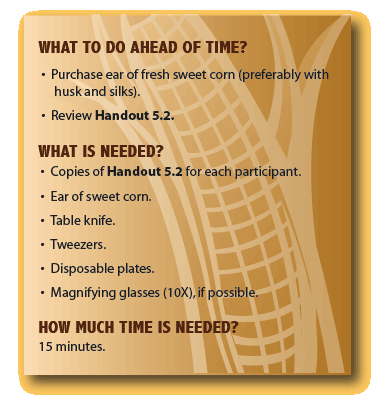
Activity 5.2: Birth of Baby Corn
(optional)

Directions
Provide participants with Handout 5.2 and the following explanation. A mature corn plant has a tassle at the top and one or two ears half-way down the plant (Photograph 1). The female corn cell (the egg) resides in the ear of the corn (Photograph 2), and the male corn cell (the pollen, Photograph 3) comes from the tassel on the top of the plant. When the pollen lands on the corn silk (the hairy part on the top of the ear, Photograph 4), the male cell travels down the silk until it mates with the egg inthe ear. When the mating occurs each cell donates half of its genetic information to the fertilized egg. That way the final fertilized egg has exactly the same amount of genetic information as the original corn cells. Once fertilized, the egg develops into a small embryo surrounded by a starchy layer (Photograph 5) that provides food for the embryo when it is exposed to water and soil and germinates. One end of the embryo forms leaves and the other the roots. Sometimes when the pollen does not reach the egg to fertilize it, the ear has gaps with no developing grain (Photograph 6).
Ask participants to remove husks from ear of corn and pass it around to the other participants. Try to leave the silks attached to the ear. Ask participants to look at the ear and try to identify individual seeds and where the silks attach to the seeds. Once everyone has seen the ear, use a knife and the cutting board to cut off seeds as close to the cob as possible. Place one or two seeds on a disposable plate for each participant. Ask them to use tweezers to open the seed to look inside. Most of what they see is starch but, at the cut end of the seed, they should see a small, firm 1/8-1/4” oval structure, the embryo, embedded in the softer, starchy tissue. Instruct participants to use the tweezers to remove the embryo, placing it on the disposable plate. Tell them to use the magnifying glass to look at the embryo.
- When using the magnifying glass to look at the embryo, describe what you see?
- Speculate what you think any structures you see might be.
- Why do you think they might be important to the developing seed?